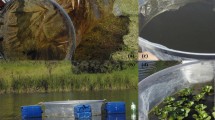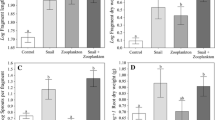Abstract
Grazing by herbivorous birds is often cited as an important factorin suppressing macrophyte development in shallow lakes undergoingrestoration, thus delaying the attainment of the stable clear waterstate. Development and succession of macrophyte communities andsize, diet and grazing pressure of coot (Fulica atra)populations upon macrophytes, were monitored over the seasonalcycle at ten shallow lakes of varying nutrient status, in theNorfolk Broads in eastern England. In spring, territorial breedingbirds were at relatively low density and included only a smallproportion of macrophytes in their diet, resulting in low grazingpressure on macrophytes. In summer, there was a significantrelationship between macrophyte cover and bird density,illustrating the importance of macrophytes in the dispersion phasefor birds following breeding. Macrophytes comprised the bulk ofbird diet where they were available and the consumption ofmacrophytes was up to 76 fold higher than in spring. However,losses to grazing in both periods were negligible when compared topotential growth rates documented in the literature. Grazingexperiments at two biomanipulated lakes confirmed that birds werenot responsible for limiting macrophytes during the springcolonisation phase or in the summer growth period. During theperiod of autumnal senescence and over the winter months where somemacrophyte species remain available, e.g. as developed individualsor dormant buds, grazing by birds may conceivably have an impact onthe development and structure of macrophyte populations insubsequent growing seasons.The relative importance of bird grazing compared to other factorslimiting the development of macrophytes in shallow lakes isdiscussed in the light of other experimental studies.
Similar content being viewed by others
References
Agami, M. & Y. Waisel, 1986. The role of mallard ducks (Anas platyrhynchos) in distribution and germination of seeds of the submerged hydrophyte Najas marinaL. Oecologia 68: 473–475.
Anderson, M. G. & J. B. Low, 1976. Use of Sago pondweed on the Delta Marsh, Manitoba. J. Wildl. Mgmt 40: 233–242.
Best, E. P. H. & J. H. A. Dassen, 1987. A seasonal study of growth characteristics, and the levels of carbohydrates and proteins in Elodea nuttallii, Polygonum amphibiumand Phragmites australis. Aquat. Bot. 28: 353–372.
Best, E. P. H. & H. C. W. Visser, 1987. Seasonal growth of the submerged macrophyte Ceratophyllum demersumL. in mesotrophic Lake Vechten in relation to insolation, temperature and reserve carbohydrates. Hydrobiologia 148: 231–243.
Blindlow, I., G. Andersson, A. Hargeby & S. Johansson, 1993. Longterm pattern of alternative stable states in two shallow eutrophic lakes. Freshwat. Biol. 30: 159–167.
Broads Authority, 1994. The Broads Plan-No Easy Answers. Broads Authority Consultation Document, Broads Authority, Norwich, England.
Cramp, S. & K. E. L. Simmons, 1980. Handbook of the Birds of Europe the Middle East and North Africa. The Birds of the Western Palearctic, Volume II. Hawks to Bustards. Oxford University Press, Oxford, UK.
Doef, R.,H. Coops, M. L. Streekstra & L. H. C. A. Hector, 1994. Waterplanten in het Wolderwijden Veluwemeer (1990–1993). RIZA nota-94.046, RIZA, Lelystad, Netherlands. ISBN 9036903440.
Draulans, D. & L. Vanherck, 1987. Food and foraging of Coot Fulica atraon fish ponds during autumn migration. Wildfowl 38: 63–69.
Esler, D., 1989. An assessment of American coot herbivory of Hydrilla. J. Wildl. Mgmt 53: 1147–1149.
Ferns, J. & J. Kirby, 1992. Waterfowl counts in the UK. 1990–91. Wildfowl 43: 235–240.
Giles, N., 1992. Wildlife after gravel: twenty years of practical research by the Game Conservancy and ARC. Game Conservancy, Fordingbridge, UK.
Hargeby, A., G. Andersson, G. Blindlow & S. Johansson, 1994. Trophic web structure in a shallow eutrophic lake during a dominance shift from phytoplankton to submerged macrophytes. Hydrobiologia 279/280: 83–90.
Harper, J. L., 1977. Population biology of plants. Academic Press Inc., London, UK.
Hosper, S. H. & E. Jagtman, 1990. Biomanipulation additional to nutrient control for restoration of shallow lakes in The Netherlands. Hydrobiologia 200/201: 523–534.
Howes, J. R. & M. R. Perrow, 1994. Macrophyte grazing by coot (Fulica atra) in the broads: bird-resource interactions. In Pitt, J.-A. & G. L. Phillips (eds), The Development of Biomanipulation Techniques & Control of Phosphorus Release from Sediments, EC LIFE project 92-3/UK/031, NRA Report No. No. 475121A. National Rivers Authority/Broads Authority, Bristol, UK.
Irvine, K.,B. Moss & H. Balls, 1989. The loss of submerged plants with eutrophication II. Relationships between fish and zooplankton in a set of experimental ponds, and conclusions. Freshwat. Biol. 22: 89–107.
Jupp, B. P. & D. H. N. Spence, 1977. Limitations of macrophytes in a eutrophic lake, Loch Leven. II. Wave action, sediments and waterfowl grazing. J. Ecol. 65: 431–446.
Kennison, G. C. B., 1993. Aquatic macrophyte surveys of the Norfolk Broads. Unpubl. report, Broads Authority, Norwich, UK.
Kiørboe, T., 1980. Distribution and production of submerged macrophytes in Tipper Grund (Ringkøbing Fjord, Denmark), and the impact of waterfowl grazing. J. appl. Ecol. 17: 675–687.
Krzyzanek, E., H. Kasza, W. Krzanowski, T. Kuflikowski & G. Paj{ie255-01}k, 1986. Succession of communities in the Goczałkowice Dam Reservoir in the period 1955–1982. Arch. Hydrobiol. 106: 21–43.
Lammens, E. H. R. R., R. D. Gulati, M.-L. Meijer & E. van Donk, 1990. The first biomanipulation conference: a synthesis. Hydrobiologia 200/201: 619–628.
Lauridsen, T. L., E. Jeppesen & F. Østergaard Andersen, 1993. Colonization of submerged macrophytes in shallow fish manipulated Lake Vaeng impact of sediment composition and waterfowl grazing. Aquat. Bot. 46: 1–15.
Lauridsen, T. L., E. Jeppesen & M. Søndergaard, 1994. Colonization and succession of submerged macrophytes in shallow Lake Vaeng during the first five years following fish manipulation. Hydrobiologia 275/276: 233–242.
Lillie, R. A. & J. O. Evrard, 1994. Influence of macroinvertebrates and macrophytes on waterfowl utilization of wetlands in the Prairie Pothole Region of northwestern Wisconsin. Hydrobiologia 279/280: 235–246.
Lodge, D. M., 1991. Herbivory on freshwater macrophytes. Aquat. Bot. 41: 195–224.
McKinnon, S. L. & S. F. Mitchell, 1994. Eutrophication and black swan (Cygnus atratusLatham) populations: tests of two simple relationships. Hydrobiologia 279/280: 163–170.
Meijer, M.-L., E. Jeppesen, E. van Donk, B. Moss, M. Scheffer, E. Lammens, E. van Nes, J. A. van Berkum, G. L. de Jong, B. A. Faafeng & J. P. Jensen, 1994. Long-term responses to fishstock reduction in small shallow lakes: interpretation of five-year results of four biomanipulation cases in The Netherlands and Denmark. Hydrobiologia 275/276: 457–466.
Mitchell, S. F., D. P. Hamilton, W. S. MacGibbon, P. K. B. Nayar & R. N. Reynolds, 1988. Interactions between phytoplankton, submerged macrophytes, black swans and zooplankton in a shallow lake. Int. Revue ges. Hydrobiol. 73: 145–170.
Moss, B., 1990. Engineering and biological approaches to the restoration from eutrophication of shallow lakes in which aquatic plant communities are important components. Hydrobiologia 200/201: 367–377.
Moss, B., H. Balls, K. Irvine & J. H. Stansfield, 1986. Restoration of two lowland lakes by isolation from nutrient-rich water sources with and without removal of sediment. J. appl. Ecol. 23: 391–414.
Moss, B., J. H. Stansfield & K. Irvine, 1990. Problems in the restoration of a hypertrophic lake by diversion of a nutrient-rich inflow. Verh. int. Ver. Limnol. 24: 409–425.
Moss, B., J. H. Stansfield, K. Irvine, M. R. Perrow & G. L. Phillips, 1996. Progressive restoration of a shallow lake–a twelve-year experiment in isolation, sediment removal and biomanipulation. J. appl. Ecol. 33: 71–86.
National Environmental Research Institute, Denmark, 1994. Report and activities 1993–94. Ministry of the Environment, Roskilde, Denmark.
National Research Council (US), 1992. Restoration of Aquatic Ecosystems-Science, Technology and Public Policy. National Academy Press, Washington D.C, USA: 552 pp.
Palmer, M., 1992. A botanical classification of standing waters in Great Britain. JNCC Publications, Peterborough, England. ISBN 1 873701 27 6.
Perrow, M. R., 1990; Biomanipulation in Broadland. In O’Grady, K. T., A. J. B. Butterworth, P. B. Spillett & J. C. J. Domaniewski (eds), Fisheries in the Year 2000, Proceedings of the 21st anniversary conference of the Institute of Fisheries Management. IFM, Nottingham, England: 335–337.
Perrow, M. R., B. Moss & J. H. Stansfield, 1994. Trophic interactions in a shallow lake following a reduction in nutrient loading: a long term study. Hydrobiologia 275/276: 43–52.
Phillips, G. L., 1976. An Investigation of the Distribution and Growth of Aquatic Plants in some of the Norfolk Broads. Unpubl. PhD thesis, University of East Anglia, Norwich, England.
Phillips, G. L., D. F. Eminson & B. Moss, 1978. A mechanism to account for macrophyte decline in progressively eutrophicated freshwaters. Aquat. Bot. 4: 103–126.
Phillips, G. L., M. R. Perrow & J. H. Stansfield, 1996. Manipulating the fish-zooplankton interaction in shallow lakes: a tool for restoration. In Greenstreet, S. P. R. & M L. Tasker (eds), Aquatic Predators and Their Prey. Blackwell Scientific Publications Ltd., Oxford. England: 174–183.
Ryding, S.-O. & W. Rast (eds), 1989. The Control of Eutrophication of Lakes and Reservoirs. UNESCO, Man & the Biosphere Series, Vol. 1, Parthenon Publishing Group, Lancs. England.
Sandsten, H., 1995. Can waterfowl grazing trigger a shift from clear to turbid water in shallow Lake Krankesjon? Master thesis, University of Lund, Sweden.
Sas, H., 1989. Lake restoration by reduction of nutrient loading: Expectations, experiences, extrapolations. Academia Verlag 497 pp.
Scheffer, M., S. H. Hosper, M.-L. Meijer, B. Moss & E. Jeppesen, 1993. Alternative Equilibria in Shallow Lakes. TREE 8: 275–279.
Schutten, J., J. A. van der Velden & H. Smit, 1994. Submerged macrophytes in the recently freshened lake system Volkerak-Zoom (The Netherlands), 1987–1991. Hydrobiologia 275/276: 207–218.
Seago, M. J., 1967. Birds of Norfolk. Jarrold & Sons, Norwich, England.
Søndergaard, M., L. Bruun, T. L. Lauridsen, E. Jeppesen & T. Vindbaek Madsen, in press. The impact of grazing waterfowl on submerged macrophytes: in situexperiments in a shallow eutrophic lake. Aquat. Bot.
Stansfield, J. H., 1994. The extent of macrophyte recovery at biomanipulated sites, and experimental evidence that bird grazing and/or water chemistry affect macrophyte establishment. In Pitt, J-A.&s G. L. Phillips (eds), The Development of Biomanipulation Techniques & Control of Phosphorus Release from Sediments, EC LIFE project 923/UK/031, NRA Report No. No. 475/2/A. National Rivers Authority/Broads Authority, Bristol, UK.
Van Donk, E., E. De Deckere, J. G. P. Klein Breteler & J. T. Meulemans 1994. Herbivory by waterfowl and fish on macrophytes in a biomanipulated lake: effects on long-term recovery. Ver. int. Ver. Limnol. 25: 2139–2143.
Author information
Authors and Affiliations
Rights and permissions
About this article
Cite this article
Perrow, M.R., Schutten, J.H., Howes, J.R. et al. Interactions between coot (Fulica atra) and submerged macrophytes: the role of birds in the restoration process. Hydrobiologia 342, 241–255 (1997). https://doi.org/10.1023/A:1017007911190
Issue Date:
DOI: https://doi.org/10.1023/A:1017007911190




